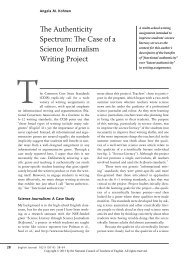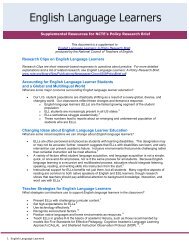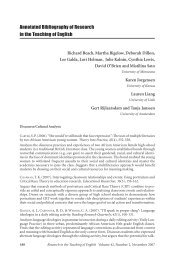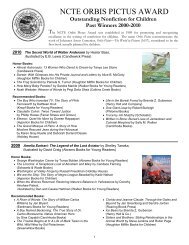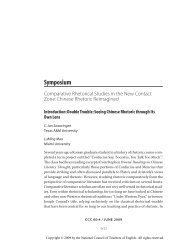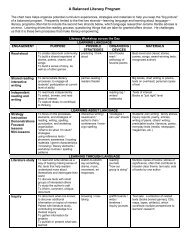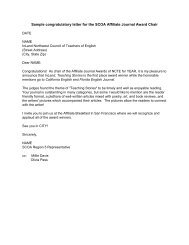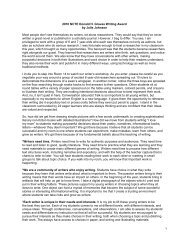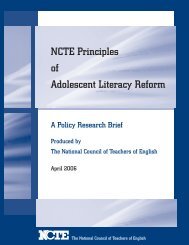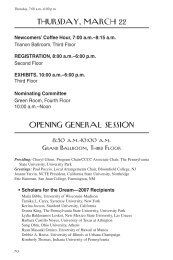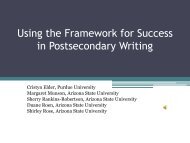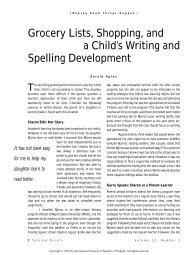Annotated Bibliography of Research in the Teaching of English
Annotated Bibliography of Research in the Teaching of English
Annotated Bibliography of Research in the Teaching of English
- No tags were found...
Create successful ePaper yourself
Turn your PDF publications into a flip-book with our unique Google optimized e-Paper software.
230 <strong>Research</strong> <strong>in</strong> <strong>the</strong> Teach<strong>in</strong>g <strong>of</strong> <strong>English</strong> Volume 41 November 2006Analyzes <strong>the</strong> read<strong>in</strong>g performance <strong>of</strong> 183 Spanish-speak<strong>in</strong>g students <strong>in</strong> K-2nd grade <strong>in</strong> threeschools with vary<strong>in</strong>g <strong>in</strong>structional programs: structured “<strong>English</strong> immersion,” developmentalbil<strong>in</strong>gual, and dual language. Exam<strong>in</strong>es factors outside <strong>of</strong> <strong>the</strong> <strong>in</strong>structional program such asethnic composition, socioeconomic level, and language use <strong>in</strong> <strong>the</strong> community; family languageand literacy activities; and <strong>the</strong>ir <strong>in</strong>terplay with <strong>the</strong> types <strong>of</strong> school programs. F<strong>in</strong>ds that whilestudents’ performance outcomes are higher <strong>in</strong> <strong>the</strong> language <strong>of</strong> <strong>in</strong>struction, attribut<strong>in</strong>g this solelyto <strong>in</strong>structional program is problematic. Suggests that language exposure at home and <strong>in</strong> <strong>the</strong>community <strong>in</strong>teracts with language <strong>of</strong> <strong>in</strong>struction at school to <strong>in</strong>fluence performance outcomes<strong>in</strong> read<strong>in</strong>g <strong>in</strong> Spanish and <strong>English</strong>, and that longer-term studies must take <strong>the</strong>se factors <strong>in</strong>toaccount.SLAVIN, R. E., & CHEUNG, A. (2005). A syn<strong>the</strong>sis <strong>of</strong> research on language <strong>of</strong> read<strong>in</strong>g <strong>in</strong>structionfor <strong>English</strong> language learners. Review <strong>of</strong> Educational <strong>Research</strong>, 75(2), 247-284.Uses a best-evidence syn<strong>the</strong>sis methodology to glean <strong>in</strong>sights from experimental studies focus<strong>in</strong>gon <strong>the</strong> effects <strong>of</strong> language <strong>of</strong> <strong>in</strong>struction for <strong>English</strong> learners’ read<strong>in</strong>g success (bil<strong>in</strong>gualversus <strong>English</strong>-only). From <strong>the</strong> systematic literature search, 17 studies were found that met<strong>in</strong>clusion standards. F<strong>in</strong>ds <strong>the</strong> majority <strong>of</strong> studies support a bil<strong>in</strong>gual approach, and a smallernumber show no difference between approaches. Of special note were <strong>the</strong> positive results obta<strong>in</strong>edfrom paired bil<strong>in</strong>gual approaches, <strong>in</strong> which students receive <strong>in</strong>struction <strong>in</strong> each languageat separate times <strong>of</strong> <strong>the</strong> school day. Stresses <strong>the</strong> need for additional high-quality studies exam<strong>in</strong><strong>in</strong>g<strong>the</strong> effects <strong>of</strong> bil<strong>in</strong>gual versus “<strong>English</strong>-immersion” <strong>in</strong>structional programs.WANG, M., PARK, Y., & LEE, K. R. (2006). Korean-<strong>English</strong> biliteracy acquisition: Cross-languagephonological and orthographic transfer. Journal <strong>of</strong> Educational Psychology, 98(1), 148-158.Exam<strong>in</strong>es <strong>the</strong> cross-language phonological and orthographic relationship for 45 1st and 3rdgrade, native Korean-speak<strong>in</strong>g students acquir<strong>in</strong>g literacy <strong>in</strong> Korean and <strong>English</strong>. While crossl<strong>in</strong>guistictransfer <strong>of</strong> phonological skills has been documented <strong>in</strong> alphabetic languages withsimilar writ<strong>in</strong>g systems, <strong>the</strong> Korean language provided an opportunity to compare alphabeticlanguages with visually dist<strong>in</strong>ct orthographies. F<strong>in</strong>ds that phonological skills <strong>in</strong> <strong>the</strong> first andsecond language were highly correlated, and that first-language phonological skills facilitatedecod<strong>in</strong>g <strong>in</strong> <strong>English</strong>. F<strong>in</strong>ds limited orthographic transfer <strong>in</strong> learn<strong>in</strong>g to read two different writ<strong>in</strong>gsystems. Results suggest <strong>the</strong> importance <strong>of</strong> pay<strong>in</strong>g attention to <strong>the</strong> specific ways students’first-language skills can be transferred to second-language literacy skills.O<strong>the</strong>r Related <strong>Research</strong>:ACHUGAR, M. (2006). Writers on <strong>the</strong> borderlands: Construct<strong>in</strong>g a bil<strong>in</strong>gual identity <strong>in</strong> SouthwestTexas. Journal <strong>of</strong> Language, Identity & Education, 5(2), 97-122.AUGUST, D., & SHANAHAN, T. (EDS.). (2006). Develop<strong>in</strong>g literacy <strong>in</strong> second-language learners: Report<strong>of</strong> <strong>the</strong> National Literacy Panel on Language M<strong>in</strong>ority Children and Youth. Mahwah, NJ:Erlbaum.BAQUEDANO-LÓPEZ, P., SOLÍS, J. L., & KATTAN, S. (2005). Adaptation: The language <strong>of</strong> classroomlearn<strong>in</strong>g. L<strong>in</strong>guistics and Education, 16(1), 1-26.BRANUM-MARTIN, L., MEHTA, P. D., FLETCHER, J. M., CARLSON, C. D., ORTIZ, A., CARLO, M., ET AL.(2006). Bil<strong>in</strong>gual phonological awareness: Multilevel construct validation among Spanish-speak<strong>in</strong>gk<strong>in</strong>dergarteners <strong>in</strong> transitional bil<strong>in</strong>gual education classrooms. Journal <strong>of</strong> Educational Psychology,98(1), 170-181.BROCK, C., & RAPHAEL, T. (2005). W<strong>in</strong>dows to language, literacy and culture: Insights from an <strong>English</strong>-languagelearner. Newark, DE: International Read<strong>in</strong>g Association.CHEUNG, A., & SLAVIN, R. E. (2005). Effective read<strong>in</strong>g programs for <strong>English</strong> language learners ando<strong>the</strong>r language-m<strong>in</strong>ority students. Bil<strong>in</strong>gual <strong>Research</strong> Journal, 29(2), 241-267.CUMMINS, J., CHOW, P., & SCHECTER, S. R. (2006). Community as curriculum. Language Arts, 83(4),297-307.



